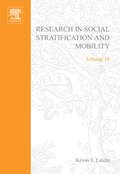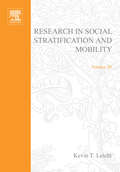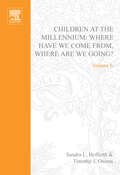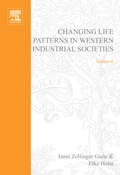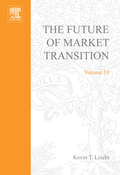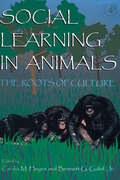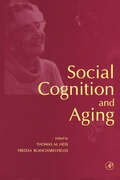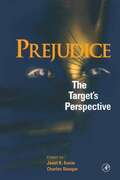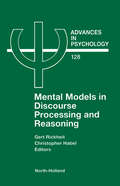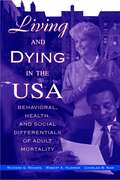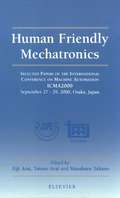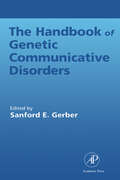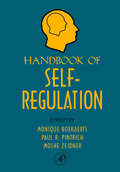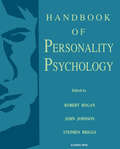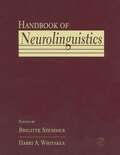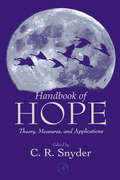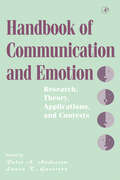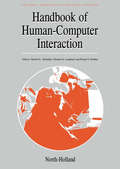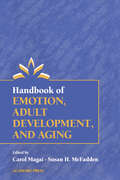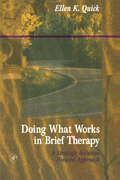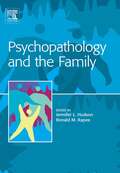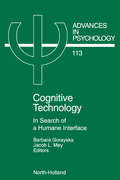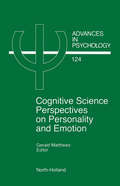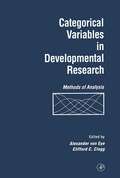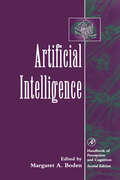- Table View
- List View
Research in Social Stratification and Mobility (ISSN #Volume 18)
by Kevin T. LeichtThis text reflects the growing diversity of perspectives, methods and insights currently used in social stratification research. Authors discuss the following broad themes from an international perspective: the changing real and symbolic boundaries of social stratification; who benefits from rapidly changing markets; immigration, marginalization and exclusion; and modelling occupational mobility. The contributions demonstrate the changing nature of social stratification systems in today's global and fragmented economy.
Research in Social Stratification and Mobility (ISSN #Volume 20)
by Kevin T. LeichtVolume 20 of "Research in Social Stratification and Mobility" continues to remain at the forefront of the diverse group of social scientists who study social inequality and is now the official publication of the Social Stratification Research Group of the International Sociological Association (RC-28). This issue features a comprehensive retrospective on the 40 years of contributions to social stratification research made by the late William Sewell and the Wisconsin Longitudinal Survey, including an all-inclusive bibliography of publications. Other contributions address the growing differences between workers with full-time jobs and various categories of the underemployed (in Israel, the United States and Germany), social mobility in Korea and Sweden, subjective responses to social inequality and the social consequences of status inconsistency, and analyses of class consciousness and growing wealth inequality in the OECD.
Children at the Millennium: Where Have We Come From? Where Are We Going? (ISSN #Volume 6)
by Timothy J. Owens Sandra L. HofferthChildren at the Millennium
Changing Life Patterns in Western Industrial Societies (ISSN #Volume 8)
by Janet Zollinger Giele Elke HolstChanging Life Patterns in Western Industrial Societies
The Future of Market Transition (ISSN #Volume 19)
by Kevin T. LeichtThe collapse of the state-controlled economies of the former Eastern Bloc will certainly change the way the global economy operates. Bringing together scholars from a wide variety of theoretical perspectives, different nations and different empirical research traditions, this title examines the ongoing transition and the implications of market transitions for individual life chances, state economic policy and social stratification systems. The volume includes scholarship that focuses on both single nation and cross-national research, plus research contributions that compare state socialist/former state socialist political economies with conditions elsewhere in the world.
Social Learning In Animals: The Roots of Culture
by Bennett G. Galef Jr. Cecilia M. HeyesThe increasing realization among behaviorists and psychologists is that many animals learn by observation as members of social systems. Such settings contribute to the formation of culture. This book combines the knowledge of two groups of scientists with different backgrounds to establish a working consensus for future research. The book is divided into two major sections, with contributions by a well-known, international, and interdisciplinary team which integrates these growing areas of inquiry.Integrates the broad range of scientific approaches being used in the studies of social learning and imitation, and society and cultureProvides an introduction to this field of study as well as a starting point for the more experienced researcherChapters are succinct reviews of innovative discoveries and progress made during the past decadeIncludes statements of varied theoretical perspectives on controversial topicsAuthoritative contributions by an international team of leading researchers
Social Cognition and Aging
by Thomas M. Hess Fredda Blanchard-FieldsMost of the research done in social cognition has been conducted with younger adults and may not be applicable to a much older population. Social Cognition and Aging provides a snapshot view of research that has been done with older adults or is directly applicable to this population. Focusing on issues of self identity, social interactions, and social perceptions, this book provides a broad overview of how aging affects one's own perceptions and actions as well as how others perceive and interact with the aged. Coverage includes such topics as self-control, memory, resilience, age stereotypes, moral development, and the "art" of living. With contributions from top researchers in both gerontology and psychology, this book is an important reference for academics and professionals alike in personality, cognition, social psychology, adult development, sociology, and gerontology.
Prejudice: The Target's Perspective
by Janet K. Swim Charles StangorPrejudice: The Target's Perspective turns the tables on the way prejudice has been looked at in the past. Almost all of the current information on prejudice focuses on the person holding prejudiced beliefs. This book, however, provides the first summary of research focusing on the intended victims of prejudice. Divided into three sections, the first part discusses how people identify prejudice, what types of prejudice they encounter, and how people react to this prejudice in interpersonal and intergroup settings. The second section discusses the effect of prejudice on task performance, assessment of ones own abilities, self-esteem, and stress. The final section examines how people cope with prejudice, including a discussion of coping mechanisms, reporting sexual harassment, and how identity is related to effective coping.Includes an introduction, the consequences of prejudice, and how to cope with prejudiceThe editors are top researchers in the field of prejudiceAll the contributors are major figures in the social psychological analysis of intergroup relationships
Mental Models in Discourse Processing and Reasoning (ISSN #Volume 128)
by G. Rickheit C. HabelIn this interdisciplinary discussion on mental models, researchers from various areas in cognitive science tackle the following questions: What is a mental model? What are the prospects and limitations in applying the mental model notion in cognitive science? How can the ideas on the nature of mental models and their mode of operation be empirically substantiated? The primary goal of the research group was to work out a definition of mental models that embraces the overall use of this construct in cognitive science as well as the more specific conceptions used in particular research domains such as cognitive linguistics. Theoretical claims about the properties of mental models were discussed and their tenability evaluated against the empirical evidence.The volume is divided into three parts. Fundamental aspects of mental models are presented in the first section, the following part contains contributions to the function of mental models in discourse processing, and finally problems of mental models in reasoning and problem solving are outlined.
Living and Dying in the USA: Behavioral, Health, and Social Differentials of Adult Mortality
by Richard G. Rogers Robert A. Hummer Charles B. NamThe simplicity of using one data set in addressing the relationship of single variables to mortality distinguishes Living and Dying in the USA from other recent investigations of mortality. The authors use the recently released National Health Interview Survey and the National Death Index to make a definitive statement about demographics and mortality. By surveying demographic and sociocultural characteristics associated with mortality, socioeconomic effects, health-related conditions, and health status, they reveal connections among several factors related to mortality chances. Easily understood and cited, their study emphasizes the statistical methods underlying their revelations and invites readers to duplicate their results.Comprehensive coverage of US adult mortality differentialsBased on a new and innovative data setIncludes factors rarely examined in related mortality researchNot only documents mortality differentials, but explores explanations for themExtensive list of references associated with each chapterConsistent, straightforward methodology used throughout aids readers in both understanding the content and in comparing results from chapter to chapter
Human Friendly Mechatronics
by Tatsuo Arai Eiji Arai Masaharu TakanoThe book includes 61 selected papers from 106 presented at the second International Conference on Machine Automation (ICMA2000). The conference focused, for the first time, on human friendly mechantronics which covers machine systems interacting with human beings, psychological, physiological, and physical behaviors of the human being itself, robotics, human-mimetic mechanical systems, commercial application examples and so on. Machine automation has owed a lot to mechatronics technology in the last decades, however, a paradigm shift is desired and emphasized in the 21st century in every aspect of our society, and mechantronics is not an exception. The paradigm shift in mechatronics is a pursuit of productivity and efficiency to the preference of humans, and it is time that a new concept of a human friendly robot must be proposed that is welcome by human users. The book aims to offer the most up-to-date and valuable information on: •Human Interface & Communication •Human Support Technology •Actuator & Control •Vision & Sensing •Robotics and Design •Manufacturing System We believe this book will bring advanced knowledge and valuable information to the industries as well as to academics and will contribute to the further development in mechatronics and its related fields.
Handbook of Genetic Communicative Disorders
by Sanford E. GerberMany professionals in the communicative sciences are relative newcomers to the understanding of genetics as it applies to communicative disorders. A speech-language clinician certainly can diagnose and treat stuttering, for example, but that clinician may not be fully aware of the role of a genetic counselor for the family of a stutterer. An audiologist may be able to assess a hearing impairment, but an understanding of the underlying genetics of that impairment would make that person a better audiologist. The medical geneticist, similarly, could have an inadequate appreciation of how our genes may affect language function. All of these professionals need a source that brings together essential ideas from related disciplines.This is a book about human communication, both normal and disordered, and how our communication abilities are affected by our genes. Many, probably most, communicative disorders are of genetic origin, even if not exclusively genetic. A knowledge of genetics, therefore, is essential to our understanding of communication, of communicative disorders, of how such disorders come about, and of how to deal with them.This is the only book to consider the genetics of communicative disorders from a broad perspective. It examines genetics, embryology, and epidemiology, along with study of the hearing, speech, and language disorders themselves. It also introduces review of issues relevant to genetic counseling and ethics. It is a unique and comprehensive work whose contributors are the leading experts in their respective disciplines.* Only book available to consider all communicative disorders* Unparalleled scrutiny of the sciences basic to the genetics of communicative disorders* Specific attention paid to clinical and ethical issues
Handbook of Self-Regulation
by Monique Boekaerts Moshe Zeidner Paul R. PintrichThe Handbook of Self-Regulation represents state-of-the-art coverage of the latest theory, research, and developments in applications of self-regulation research. Chapters are of interest to psychologists interested in the development and operation of self-regulation as well as applications to health, organizational, clinical, and educational psychology. This book pulls together theory, research, and applications in the self-regulation domain and provides broad coverage of conceptual, methodological, and treatment issues. In view of the burgeoning interest and massive research on various aspects of self-regulation, the time seems ripe for this Handbook, aimed at reflecting the current state of the field. The goal is to provide researchers, students, and clinicians in the field with substantial state-of-the-art overviews, reviews, and reflections on the conceptual and methodological issues and complexities particular to self-regulation research.Coverage of state-of-the-art in self-regulation research from different perspectivesApplication of self-regulation research to health, clinical, organizational, and educational psychologyBrings together in one volume research on self-regulation in different subdisciplinesMost comprehensive and penetrating compendium of information on self-regulation from multi-disciplinary perspectives
Handbook of Personality Psychology
by Robert Hogan John Johnson Stephen BriggsThe most comprehensive single volume ever published on the subject, the Handbook of Personality Psychology is the end-all, must-have reference work for personality psychologists. This handbook discusses the development and measurement of personality as well as biological and social determinants, dynamic personality processes, the personality's relation to the self, and personality in relation to applied psychology. Authored by the field's most respected researchers, each chapter provides a concise summary of the subject to date. Topics include such areas as individual differences, stability of personality, evolutionary foundations of personality, cross-cultural perspectives, emotion, psychological defenses, and the connection between personality and health. Intended for an advanced audience, the Handbook of Personality Psychology will be your foremost resource in this diverse field.Chapter topics include:* Nature of personality psychology* Conceptual and measurement issues in personality* Developmental issues* Biological determinants of personality* Social determinants of personality* Dynamic personality processes* Personality and the self* The Five Factor Model* Applied psychology
Handbook of Neurolinguistics
by Harry A. Whitaker Brigitte StemmerThe Handbook of Neurolinguistics is a state-of-the-art reference and resource book; it describes current research and theory in the many subfields of neurolinguistics and its clinical application. Thorough and clearly written, the handbook provides an excellent overview of the field of neurolinguistics and its development. The book is organized into five parts covering the history of neurolinguistics, methods in clinical and experimental neurolinguistics, experimental neurolinguistics, clinical neurolinguistics, and resources in neurolinguistics. The first four parts contain a wide range of topics which discuss all important aspects of the many subfields of neurolinguistics. Also included are the relatively new and fast developing areas of research in discourse, pragmatics, and recent neuroimaging techniques. The resources section provides currently available resources, both traditional and modern. The handbook is useful to the newcomer to the field, as well as the expert searching for the latest developments in neurolinguistics.Clearly written and well organizedProvides extensive resourcesDiscusses both history and current researchCovers the many subfields of neurolinguistics as well the developing areas of research
Handbook of Hope: Theory, Measures, and Applications
by C. Richard SnyderHope has previously been a construct more of interest to philosophy and religion than in psychology. New research has shown, however, that hope is closely related to optimism, feelings of control, and motivation toward achieving one's goals. The Handbook of Hope presents a comprehensive overview of the psychological inquiry into hope, including its measurement, its development in children, how its loss is associated with specific clinical disorders, and therapeutic approaches that can help instill hope in those who have lost theirs. A final section discusses hope in occupational applications: how the use of hope can make one a better coach, teacher, or parent.Defines hope as a construct and describes development of hope through the lifespanProvides multiple instruments for measuring hopeGuides professionals in how to assess hope levels & implement hope as part of therapyRelates hope to all portions of the populationIncludes case studies, figures, and tables to aid understanding of research findings and concepts; discusses the importance of hope to relationships, achieving goals, and success at work
Handbook of Communication and Emotion: Research, Theory, Applications, and Contexts
by Peter A. Andersen Laura K. GuerreroEmotion is once again at the forefront of research in social psychology and personality. The Handbook of Communication and Emotion provides a comprehensive look at the questions and answers of interest in the field: How are specific emotions (fear, jealousy, anger, love) communicated? How does the effectiveness, or ineffectiveness, of this communication affect relationships? How is the communication of emotion utilized to deceive, or persuade, others? This important reference work is edited by top researchers in the field of communication and authored by a who's who in emotion and communication.Provides a comprehensive look at the role of communication in emotionIncludes contributions from top researchers in the field of communicationsExamines how specific emotions are communicatedIncludes important new research on the effect of communication on relationships
Handbook of Human-Computer Interaction
by M. G. Helander T. K. Landauer P. V. PrabhuThis completely revised edition, of the Handbook of Human-Computer Interaction, of which 80% of the content is new, reflects the developments in the field since the publication of the first edition in 1988. The handbook is concerned with principles for design of the Human-Computer Interface, and has both academic and practical purposes. It is intended to summarize the research and provide recommendations for how the information can be used by designers of computer systems. The volume may also be used as a reference for teaching and research. Professionals who are involved in design of HCI will find this volume indispensable, including: computer scientists, cognitive scientists, experimental psychologists, human factors professionals, interface designers, systems engineers, managers and executives working with systems development. Much of the information in the handbook may also be generalized to apply to areas outside the traditional field of HCI.
Handbook of Emotion, Adult Development, and Aging
by Carol Magai Susan H. McFaddenThe field of emotions research has recently seen an unexpected period of growth and expansion, both in traditional psychological literature and in gerontology. The Handbook of Emotion, Adult Development, and Aging provides a broad overview and summary of where this field stands today, specifically with reference to life course issues and aging. Written by a distinguished group of contributing authors, the text is grounded in a life span developmental framework, while advancing a multidimensional view of emotion and its development and incorporating quantitative and qualitative research findings.The book is divided into five parts. Part One discusses five major theoretical perspectives including biological, discrete emotions, ethological, humanistic, and psychosocial. Part Two on affect and cognition discusses the role of emotion in memory, problem solving, and internal perceptions of self and gender. Part Three on emotion and relationships expands on the role of emotion in sibling and parent/child relationships, as well as relationships between friends and romantic partners, and the emotional reaction to interpersonal loss across the life span. Part Four on stress, health, and psychological well-being treats issues of stress and coping, religion, personality, and quality of life. The final part on continuity and change in emotion patterns and personality discusses emotion and emotionality throughout the life span.An ideal reference source for professionals across a wide range of disciplines, the text summarizes recent important developments in this fast growing area of psychology and proposes many new directions for future research.Provides a biopsychological view on emotion in adulthood from a life span contextPresents the new perspective on emotion in older adults actively engaged in emotion self-regulationDescribes the intimate connection between emotion and the structure of personalityDemonstrates a new perspective on what emotion is, its importance across the life span, its connections with cognition, its role in interpersonal relation, and the way it influences both stability and change in adulthoodIllustrates the interpersonal nature of emotionProvides theoretically based, leading edge research from international authorsFive areas of coverage include: Theoretical perspectivesAffect and cognitionEmotion and relationshipsStress, health, and psychological well-beingContinuity and change in emotion patterns and personality Coverage includes: Five major theoretical perspectives, including biological, discrete emotions, ethological, humanistic, and psychosocialThe role of emotion in memory, problem-solving, and internal perceptions of self and genderThe role of emotion in sibling and parent/child relationships, relationships between friends and romantic partners, and the emotional reaction to interpersonal loss across the lifespanIssues of stress and coping, religion, personality, and quality of lifeEmotion and emotionality throughout the lifespan
Doing What Works in Brief Therapy: A Strategic Solution Focused Approach (ISSN)
by Ellen K. QuickThe first of its kind, Doing What Works in Brief Therapy is a guidebook to strategic solution focused therapy, a model which combines the principles and techniques of the Mental Research Institute's brief strategic therapy and the Brief Family Therapy Center's solution focused therapy. The book explains how the strategic emphasis on clarification of the problem and interruption of what does not work can complement and enhance the solution-focused emphasis on amplification of what does work. The text reviews the theory and presents specific treatment techniques. Case examples illustrate how the model has been used in brief, intermittent, and single-session therapy in a managed care setting. Brief psychotherapy doesn't have to result in chronic frustration for the therapist or superficial, second-rate care for the client. This book presents an approach that is upbeat, practical, and eminently workable in managed care. The reader learns to focus on critical issues with exquisite precision and to construct creative, individualized interventions that amplify what works and interrupt what does not.Integrates strategic therapy and solution focused therapyIncludes guidelines for intervention and when to do whatProvides applications for couples: indications for separate or joint sessionsConsiders both therapy and medication as successful and unsuccessful solutionsFeatures excerpts and clinically rich examples
Psychopathology and the Family
by Jennifer Hudson Ron RapeeUnderstanding the factors that place an individual at greater risk of developing psychopathology has important implications for both treatment and prevention of psychological disorders. Of critical relevance in this regard is the exploration of the potential influence of the family. Parenting and the family environment are considered to significantly contribute to a child's early development and adjustment. It follows then that parental behavior may also be of importance in the development, maintenance and or the prevention of psychopathology. Over the past 50 years there has been a considerable amount of research as well as controversy surrounding the link between parenting and psychopathology. The purpose of this book is to provide researchers and clinicians with state-of-the art research findings, presented by experts in the field, on the role of the family in the development and maintenance of psychopathology. This edited book is divided into 3 sections. The first addresses broader issues of theory and methodology and the second provides separate chapters relating to the role of the family in the development and maintenance of specific psychopathologies. A final section discusses the involvement of the family in treatment and prevention.
Cognitive Technology: In Search of a Humane Interface (ISSN #Volume 113)
by J. L. Mey B. GorayskaIn this book the editors have gathered a number of contributions by persons who have been working on problems of Cognitive Technology (CT). The present collection initiates explorations of the human mind via the technologies the mind produces. These explorations take as their point of departure the question What happens when humans produce new technologies? Two interdependent perspectives from which such a production can be approached are adopted:• How and why constructs that have their origins in human mental life are embodied in physical environments when people fabricate their habitat, even to the point of those constructs becoming that very habitat• How and why these fabricated habitats affect, and feed back into, human mental life.The aim of the CT research programme is to determine, in general, which technologies, and in particular, which interactive computer-based technologies, are humane with respect to the cognitive development and evolutionary adaptation of their end users. But what does it really mean to be humane in a technological world? To shed light on this central issue other pertinent questions are raised, e.g.• Why are human minds externalised, i.e., what purpose does the process of externalisation serve?• What can we learn about the human mind by studying how it externalises itself? • How does the use of externalised mental constructs (the objects we call 'tools') change people fundamentally?• To what extent does human interaction with technology serve as an amplification of human cognition, and to what extent does it lead to a atrophy of the human mind?The book calls for a reflection on what a tool is. Strong parallels between CT and environmentalism are drawn: both are seen as trends having originated in our need to understand how we manipulate, by means of the tools we have created, our natural habitat consisting of, on the one hand, the cognitive environment which generates thought and determines action, and on the other hand, the physical environment in which thought and action are realised. Both trends endeavour to protect the human habitat from the unwanted or uncontrolled impact of technology, and are ultimately concerned with the ethics and aesthetics of tool design and tool use.Among the topics selected by the contributors to the book, the following themes emerge (the list is not exhaustive): using technology to empower the cognitively impaired; the ethics versus aesthetics of technology; the externalisation of emotive and affective life and its special dialectic ('mirror') effects; creativity enhancement: cognitive space, problem tractability; externalisation of sensory life and mental imagery; the engineering and modelling aspects of externalised life; externalised communication channels and inner dialogue; externalised learning protocols; relevance analysis as a theoretical framework for cognitive technology.
Cognitive Science Perspectives on Personality and Emotion (ISSN #Volume 124)
by G. MatthewsThis book aims to highlight the vigour, diversity and insight of the various cognitive science perspectives on personality and emotion. It aims also to emphasise the rigorous scientific basis for research to be found in the integration of experimental psychology with neuroscience, connectionism and the new evolutionary psychology. The contributors to this book provide a wide-ranging survey of leading-edge research topics. It is divided into three parts, on general frameworks for cognitive science, on perspectives from emotion research, and on perspectives from studies of personality traits.
Categorical Variables in Developmental Research: Methods of Analysis
by Alexander Von Eye Clifford C. CloggCategorical Variables in Developmental Research provides developmental researchers with the basic tools for understanding how to utilize categorical variables in their data analysis. Covering the measurement of individual differences in growth rates, the measurement of stage transitions, latent class and log-linear models, chi-square, and more, the book provides a means for developmental researchers to make use of categorical data.Measurement and repeated observations of categorical data Catastrophe theoryLatent class and log-linear modelsApplications
Artificial Intelligence (Handbook Of Perception And Cognition)
by Margaret A. BodenArtificial Intelligence is the study of how to build or program computers to enable them to do what minds can do. This volume discusses the ways in which computational ideas and computer modeling can aid our understanding of human and animal minds. Major theoretical approaches are outlined, as well as some promising recent developments. Fundamental philosophical questions are discussed along with topics such as: the differences between symbolic and connectionist AI, planning and problem solving, knowledge representation, learning, expert systems, vision, natural language, creativity, and human-computer interaction. This volume is suitable for any psychologist, philosopher, or computer scientist wanting to know the current state of the art in this area of cognitive science.Up-to-date account of how computational ideas and techniques are relevant to psychologyIncludes discussions of "classical" (symbolic) AI, of connectionism (neural nets), of evolutionary programming, and of A-LifeDiscusses a wide range of psychology from low-level vision to creativity
